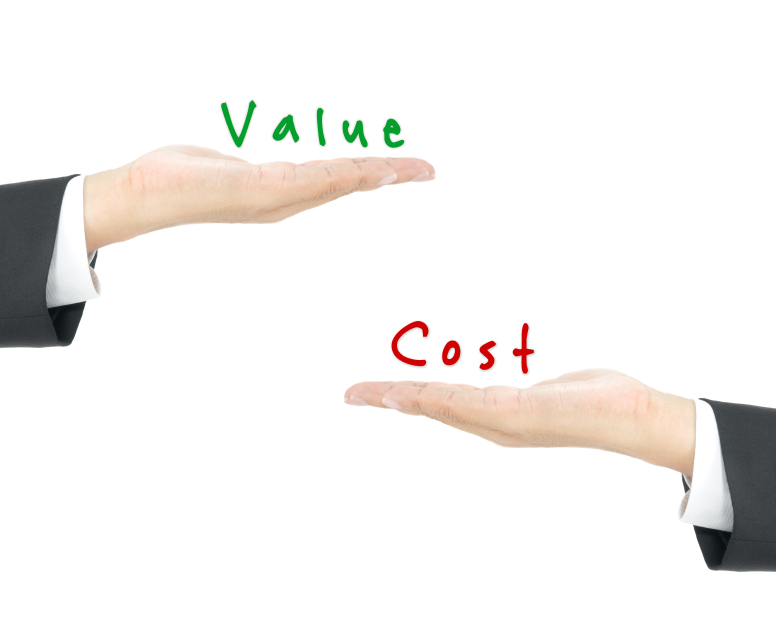Those of you who frequent my blog will know I occasionally make reference to “The Law of Economic Value”. I am now calling it “The Law of Imbalanced Value”©. The reasons will become apparent.
That law states:
“All economic value accruing to your firm has as its source, the customer’s perception that they will receive greater economic, emotional, political or physical value from your product or service, than it costs them economically, emotionally, politically or physically to acquire and use.” ©
When we consider any investment of time, energy, money or emotion, we hope for a meaningful return on that investment. We look for an investment that will make us more money (economic), make us feel good (emotional), help us look good to the right people (political) and/or relieve our stress or pain (physical). If some combination of those benefits are not envisioned, we will not be motivated to invest. If the mix of those benefits is not delivered in the optimum relative proportions, we will not re-buy.
The relative levels and mix of the four customer-received value attributes (economic, emotional, political and physical) is a business’ complete value proposition.
At the receiving end, a mix of those same four value attributes must be expended by the customer to buy and use a product.
A common example of the range of complexities associated with this law of imbalanced value and the relative value attribute mix, becomes apparent by considering the process of buying a diamond engagement ring. Imagine the complexity, mix and range value attributes considered in such a purchase.
Thank goodness our B2B world is simpler.
Or is it?
The Value Quotient (and why it must always be greater than 1)
Value, by definition, equals benefits divided by cost. It is a quotient.
The Law of Imbalanced Value © defines the Value Quotient as the Sum of Perceived Value Attributes Received by the customer (benefits) divided by the Sum of Perceived Value Attributes expended by the customer (cost).
This equation needs to yield a perception or feeling on the part of the buyer of a return much greater than 1, or much greater than break even. If that perception is not triggered, the purchase will not be worthy of consideration.
This means the value quotient must be significantly imbalanced in favor of the customer. It also means that the customer must consider all contributing value attributes in their decision process. It also means that a customer-centric marketing and sales process must incorporate the defacto creation, communication and use of that quotient.
The following questions can help you assess and appropriately adjust your value attributes to deliver a perceived imbalanced value quotient to customers.
1. Have you surveyed your customers to ask what value attributes they receive from your products and your firm – and in what order of importance?
I confess to being surprised when I did that survey for my own business several years ago. That answer was flattering, but not what I expected. The result of that survey was an increase in the amount I am investing in what they told me was important vs. what I had thought was important.
You will probably, need to face some cold truths when you see the results of your survey too. Then you must exhibit the humility and courage to reallocate time, money and people to reinforce what customers perceive as valuable. It may be painful, but the reward is less wasted resources on non-customer-value producing activities (see our related post on “Applying Lean in Marketing & Sales”), higher sales and higher marketing & sales ROI.
2. Do customers in all your target markets perceive the set of value attributes delivered by your product/service in the same proportions?
Probably not.
Sub-sets of customers with similar value-attribute profiles form a de facto market segment. Whether or not they fit neatly into, or can be labeled as, a traditional vertical or demographic category is irrelevant.
This kind of market segmentation, based on a common mix of value-attributes received, permits a narrow and cost effective focus on those segments. In these segments the profile of value-received delivers the highest value quotient to customers. This approach typically results in less price competition, higher differentiation and more effective peer-to-peer communication throughout your customer community.
In other words, a common value attribute profile defines your customer community.
3. Do your marketing and sales activities (from product definition and design, through marketing and sales, to customer service) consciously integrate and align the four customer-received value attributes with your target market?
Many small to mid-sized B2B businesses still adhere to a one-dimensional, surface-level economic benefits approach to marketing and sales. As differentiation they may tack on customer service and good relationships. This approach leaves too many unprotected dimensions of value that competitors will exploit.
4. Do your recruiting and training programs communicate and inculcate in your employees and culture your unique formulation of the Law of Imbalanced Value?”
A firm’s value proposition, its unique combination of the four value attributes it delivers, must not be left to the passive process of osmosis, any more than recruiting and training a new member of a football team can be left to chance. The new player must integrate into the team’s system, practice and train hard.
A Non-Action Call to Action
I call on you to think. Not do, but think. Not multi-task. Think.
This is the first, and most common barrier to overcome in achieving the insights and benefits that can accrue from designing your business around the “Law of Imbalanced Value”. Ask your customers, group them by common value attributes and optimize their value quotient.
*****
Copyright 2015 Jerry Vieira, CMC and The QMP Group, Inc. All Rights Reserved
For more information on the process of optimizing the value model and incorporating the Law of Imbalanced Value into your business, call Jerry Vieira, CMC at 503.318.2696 or email Jerry@qmpassociates.com. You can also elect to describe your challenges through our Contact Us page
